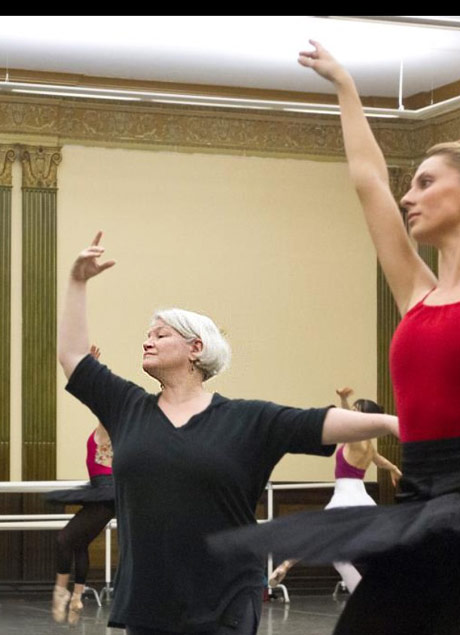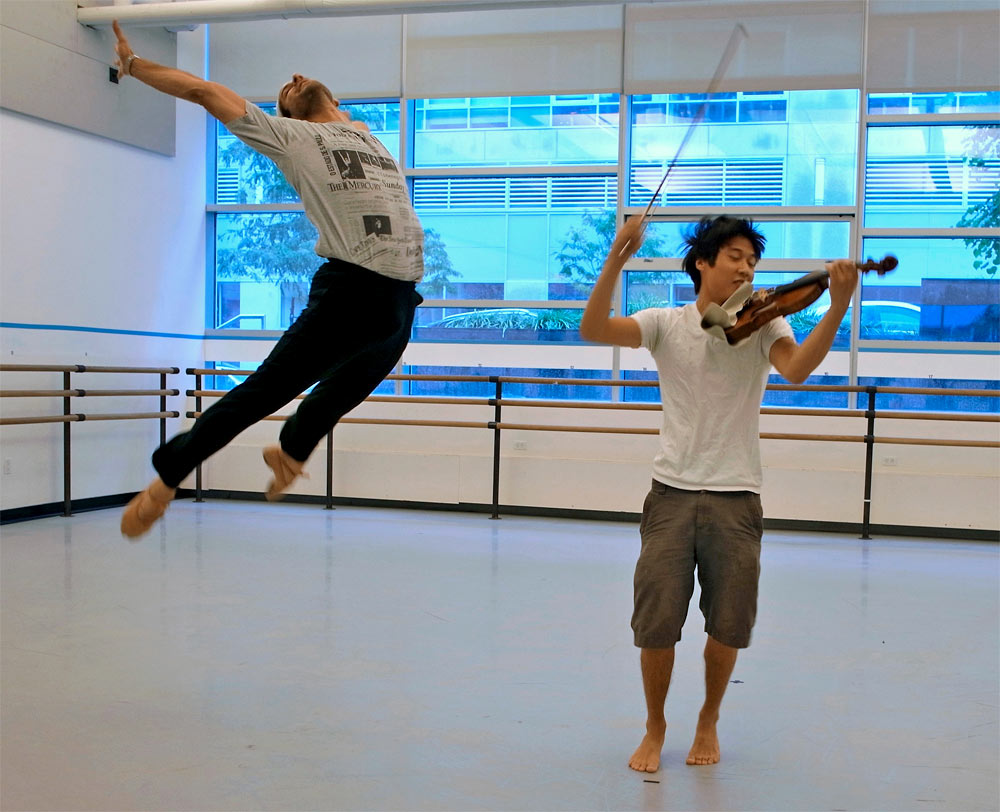
© Richard Avedon. (Click image for larger version)
Bringing Bach Partita Back
www.abt.org
Details of Bach Partita on www.twylatharp.org
ABT Fall 2013 performances
Like waking dreams, dances melt away even as they pass before our eyes. What remains is an outline, an impression. As Balanchine said, dances are like butterflies. Balanchine himself made hundreds of ballets, scores of which have been forgotten. Because of the ephemeral nature of choreography, it’s unusual for a ballet that has lain dormant for decades to return to life. But this fall, it will happen at American Ballet Theatre. Twyla Tharp’s Bach Partita, created for the company in 1983, was last performed there twenty-eight years ago. This fall, as part of its fall season at the Koch Theatre, the company will revive it.

The dancers for whom Bach Partita was created – Cynthia Gregory, Martine van Hamel, Magali Messac (alternating with Cynthia Harvey), Fernando Bujones, Clark Tippet and Robert La Fosse – have all retired. Two of them, Bujones and Tippet, are no longer with us. But the ballet mistress, Susan Jones – who assisted Tharp in 1983 – has long had an itch to bring it back. “I first spoke to Twyla about it in the late nineties,” she told me recently. “We were doing Push Comes to Shove in London, and I said to her, ‘Bach Partita is going to be lost.’” Jones also made a case for the revival to the staff at ABT. “I talked with Kevin [McKenzie, ABT’s artistic director] about reviving it from year to year.” But there were reservations; a revival of this scale requires a big investment of time, and time is money. It’s a sprawling piece, with thirty-six dancers – six principals, seven soloist couples, and a corps of sixteen. And the choreography is dizzyingly complex. As the New Yorker critic, Arlene Croce, wrote in 1983, the impression it creates is of “four or six ballets…going on at once.”

But there were other considerations, too. According to Jones, Tharp had doubts both about casting (“she was always wedded to the first cast”) and about the quality of the musical accompaniment. The ballet is set to Bach’s Partita in D minor, a thirty-minute virtuoso showpiece for solo violin. It is considered one of the greatest works ever written for the instrument. Tharp used a recording by Jascha Heifetz during rehearsals. As a result, the steps contain the DNA of that violinist’s brilliant interpretation. Afterwards, it was difficult to find a player who could measure up to Heifetz, who would also have the modesty to consider the needs of the dancers. Dancers need a consistent meter, a strong rhythmic backbone, and tempi that are neither too fast nor two slow. And Bach Partita isn’t just any dance. Tharp has crammed a huge number of steps into the music, often with little or no transition. “I remember Bach Partita being hard,” says Robert La Fosse (whose role will be performed by Calvin Royal and Craig Salstein on alternating nights) “with lots of changes of direction, and steps going the opposite way of what was natural for the body. Twyla added lots of complications to the ballet vocabulary.”
Technically, the company has never looked better. The two casts who will perform in the revival include Polina Semionova, a recent recruit from the Berlin State Opera Ballet, the flame-haired powerhouse Gillian Murphy, no stranger to Tharp’s signature blend of cool intensity, James Whiteside, a strong, adaptable dancer with a knack for allegro footwork and tricky partnering and Marcelo Gomes, who can do just about anything. Add to that a few up-and-comers: Calvin Royal III, Isabella Boylston, and Joseph Gorak. A third cast is learning the ballet just in case. April Giangeruso, a corps member who is understudying Semionova’s role (originally Martine Van Hamel’s), is one to watch: regal, strong, cool. And smart. Throughout the six-week rehearsal period she’s been carrying around a notebook, each page filled with neat lines of text listing each and every step she has to dance. “I go over the steps in my mind when I’m on the train,” she says.

© Susan Jones archive snapshot.
It takes a certain chutzpah to create a big ballet to a thirty-minute piece for solo violin by Bach. The consensus in 1983 was that Tharp had pulled it off. “Bach Partita was massive in its resources yet not at all weighty,” the dance critic, Mindy Aloff, who reviewed the première, recently told me. Like the music, the dance seemed to flow from an inexhaustible source, driving single-mindedly toward its conclusion, never coming up for air. “The push and force it takes to accomplish what Twyla is asking for is intrinsic to the style,” Jones explains. “It makes the dancers economize their movements. But the effort contributes to the dynamics of the work.” Classical steps are taken at warp speed, performed while turning, traveling through space, changing direction or bending in unexpected ways. The women use every permutation of the pointe shoe: full pointe, half pointe, quarter point, flat. Tharp’s rapidly-shifting canvas adds to the excitement. But it also complicates the process of reconstruction. There are a lot of steps to remember, and there were no notes to rely on.
So Jones went back to the archives. There were two tapes of Partita. One, a recording of a rehearsal, was made before the ballet was complete, on a day when several dancers were unavailable. The other was a performance tape taken from the back of the cavernous Metropolitan Opera House. The tiny dancers were barely visible because of the brightness of the stage lights. In a painstaking process that lasted over a year, Jones went back and forth between the two, writing down every step in her own shorthand. The notes fill two binders. At a recent rehearsal, she flipped through the pages to confirm detail (“there, the heel is on the floor, not off”), and logistics (“hold her waist for the promenade”). Certain dancers, like the corps member Luciana Paris, seemed to pick up the nuances immediately, becoming the go-to person for everyone else. “Did we do it like this or like this?” someone would ask, and she would quickly sketch out the passage, while counting. Jones welcomed her input. In rehearsal she is unflappable, firm but kind.

© Ines Laimins. (Click image for larger version)
In general, the process goes like this: Jones sets the steps, and then Tharp comes in and tweaks them to her taste. A small adjustment can dramatically alter the color of a phrase. As can the interpretation of the violinist. For the revival, ABT has hired Charles Yang, a twenty-five-year-old Juilliard graduate who, according to the Boston Globe, “plays classical violin with the charisma of a rock star.” (I can attest to the quality of his playing, if not his rock-star charisma, because I sometimes hear him practicing through my bathroom window. He lives around the corner.) More crucially in this case, he’s a willing collaborator. Unlike a lot of virtuosos, he’s excited to work with dancers, and understands their needs. (He has worked with Marcelo Gomes on some of his free-lance projects.) At the Koch Theatre, he will play while standing on a raised platform, facing a monitor so he can see what the dancers are doing. He has to pay attention to specific cues: “there’s a plié I have to watch for – that’s how I know when to start a section.” Like a lot of Baroque music, the four pieces in the partita are based on dance forms: the allemande, the courante, the sarabande, and the chaconne. The dance impulse is embedded in the music. For good measure, Yang has studied Tharp’s beloved Heifetz recording. He recently played the piece for one of his teachers, Glenn Dicterow of the New York Philharmonic. It turns out Dicterow was once a student of Heifetz’s. Music, like dance, has a lineage. Secrets, passed down from one generation to the next.

















[…] is bringing back Twyla Tharp’s “Bach Partita,” this week, at Lincoln Center. For this advance piece, I spoke with Susan Jones (the ballet mistress who is doing the staging), a couple of dancers, […]
Can’t wait to see the 2nd cast with Veronika Part in the Van Hamel role!
You know, it’s always interesting to me to hear about how people understand Bach. I was about nineteen when a friend gave me a copy of the complete cello sonatas played by Janos Starker. This was his second time recording the complete set. It was only then that I was able to understand the deep joy of dancing and singing that is so ever-present in his music. When I was talking w Ormsby Wilkins the other day we talked about this revival and he stated his opinion that musicians always come back to Bach. I hope the audience embraces this work.